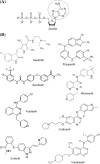Anti-angiogenic tyrosine kinase inhibitors: what is their mechanism of action?
- PMID: 20012482
- PMCID: PMC2845892
- DOI: 10.1007/s10456-009-9160-6
Anti-angiogenic tyrosine kinase inhibitors: what is their mechanism of action?
Abstract
Tyrosine kinases are important cellular signaling proteins that have a variety of biological activities including cell proliferation and migration. Multiple kinases are involved in angiogenesis, including receptor tyrosine kinases such as the vascular endothelial growth factor receptor. Inhibition of angiogenic tyrosine kinases has been developed as a systemic treatment strategy for cancer. Three anti-angiogenic tyrosine kinase inhibitors (TKIs), sunitinib, sorafenib and pazopanib, with differential binding capacities to angiogenic kinases were recently approved for treatment of patients with advanced cancer (renal cell cancer, gastro-intestinal stromal tumors, and hepatocellular cancer). Many other anti-angiogenic TKIs are being studied in phase I-III clinical trials. In addition to their beneficial anti-tumor activity, clinical resistance and toxicities have also been observed with these agents. In this manuscript, we will give an overview of the design and development of anti-angiogenic TKIs. We describe their molecular structure and classification, their mechanism of action, and their inhibitory activity against specific kinase signaling pathways. In addition, we provide insight into what extent selective targeting of angiogenic kinases by TKIs may contribute to the clinically observed anti-tumor activity, resistance, and toxicity. We feel that it is of crucial importance to increase our understanding of the clinical mechanism of action of anti-angiogenic TKIs in order to further optimize their clinical efficacy.
Figures




References
-
- Hanahan D, Weinberg RA. The hallmarks of cancer. Cell. 2000;100:57–70. - PubMed
-
- Bergers G, Benjamin LE. Tumorigenesis and the angiogenic switch. Nat Rev Cancer. 2003;3:401–410. - PubMed
-
- Folkman J. What is the evidence that tumors are angiogenesis dependent? J Natl Cancer Inst. 1990;82:4–6. - PubMed
-
- Verheul HM, Voest EE, Schlingemann RO. Are tumours angiogenesis-dependent? J Pathol. 2004;202:5–13. - PubMed
-
- Folkman J. Tumor angiogenesis: therapeutic implications. N Engl J Med. 1971;285:1182–1186. - PubMed
Publication types
MeSH terms
Substances
LinkOut - more resources
Full Text Sources
Other Literature Sources

